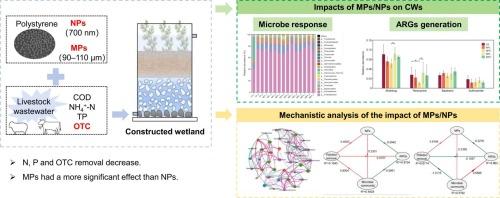Effect of microplastics concentration and size on pollutants removal and antibiotic resistance genes (ARGs) generation in constructed wetlands: A metagenomics insight
IF 11.3
1区 环境科学与生态学
Q1 ENGINEERING, ENVIRONMENTAL
引用次数: 0
Abstract
The accrual of microplastics (MPs) and antibiotics poses synergistic threats to the environment. This study systemically examined the effect of environmental-level (μg/L) MPs (90–110 µm) and nanoplastics (NPs, 700 nm) on constructed wetlands (CWs) treating oxytetracycline-contaminated wastewater via metagenomics analysis. Polystyrene (PS) MPs notably hindered the removal of nitrogen, phosphorus, and oxytetracycline, particularly at high level (1000 μg/L), with removal rates of 73.34 %, 59.59 %, and 99.34 %, respectively. Among them, the removal of NH4+-N decreased the most in comparison to CK, at 15.26 %. Antibiotic resistance genes (ARGs) copies/16S rRNA ranged from 0.26 to 0.42 in CWs, exceeding that found in rivers by a factor of 1.5 to 2.5 times. The relative abundance of multidrug resistance genes (mdtB, acrB, mexF, mdtC, and mexT) and tetracycline resistance genes (txtA, tetG, and tetP) exhibited a pronounced increase under MPs exposure, ranging from 0.06 to 0.14 and 0.01 to 0.08 copies/16S rRNA, respectively. Redundancy and network analyses emphasized robust associations among contaminant reduction, ARG abundance, and microbial community. Partial least squares path modeling indicated MPs exerted a more profound influence on pollutant removal (coefficient = 0.8194), microbial community (coefficient = 0.3358) and ARGs dissemination (coefficient = 0.6566) compared to NPs. MPs concentrations significantly affects pollutants removal and ARGs proliferation, and MPs with larger sizes amplified ARG dissemination. This research highlights the influence of MPs on CW-mediated wastewater treatment and ARGs accumulation, offering valuable insights for developing ecological wastewater treatment strategies tailored to multi-pollutant scenarios. These insights are fundamental in developing sustainable solutions to the adverse impacts of MPs on ecosystems.

微塑料的浓度和大小对建构湿地污染物清除和抗生素耐药基因(ARGs)生成的影响:元基因组学的启示
微塑料(MPs)和抗生素的累积对环境构成了协同威胁。本研究通过元基因组学分析,系统研究了环境水平(μg/L)的MPs(90-110 μm)和纳米塑料(NPs,700 nm)对处理土霉素污染废水的人工湿地(CWs)的影响。聚苯乙烯(PS)多孔塑料明显阻碍了氮、磷和土霉素的去除,尤其是在高浓度(1000 μg/L)时,去除率分别为 73.34%、59.59% 和 99.34%。其中,与 CK 相比,NH4+-N 的去除率下降最多,为 15.26%。化武中的抗生素耐药基因(ARGs)拷贝数/16S rRNA 在 0.26 至 0.42 之间,是河流中的 1.5 至 2.5 倍。多药耐药基因(mdtB、acrB、mexF、mdtC 和 mexT)和四环素耐药基因(txtA、tetG 和 tetP)的相对丰度在 MPs 暴露下明显增加,分别为 0.06 至 0.14 和 0.01 至 0.08 个拷贝/16S rRNA。冗余和网络分析强调了污染物减少、ARG 丰度和微生物群落之间的密切联系。偏最小二乘法路径模型显示,与 NPs 相比,MPs 对污染物去除(系数 = 0.8194)、微生物群落(系数 = 0.3358)和 ARGs 传播(系数 = 0.6566)的影响更为深远。MPs 的浓度对污染物的去除和 ARGs 的增殖有明显影响,尺寸较大的 MPs 会扩大 ARGs 的传播。这项研究强调了 MPs 对以 CW 为媒介的废水处理和 ARGs 积累的影响,为开发适用于多污染物情况的生态废水处理策略提供了宝贵的见解。这些见解对于制定可持续的解决方案,解决 MPs 对生态系统的不利影响至关重要。
本文章由计算机程序翻译,如有差异,请以英文原文为准。
求助全文
约1分钟内获得全文
求助全文
来源期刊

Journal of Hazardous Materials
工程技术-工程:环境
CiteScore
25.40
自引率
5.90%
发文量
3059
审稿时长
58 days
期刊介绍:
The Journal of Hazardous Materials serves as a global platform for promoting cutting-edge research in the field of Environmental Science and Engineering. Our publication features a wide range of articles, including full-length research papers, review articles, and perspectives, with the aim of enhancing our understanding of the dangers and risks associated with various materials concerning public health and the environment. It is important to note that the term "environmental contaminants" refers specifically to substances that pose hazardous effects through contamination, while excluding those that do not have such impacts on the environment or human health. Moreover, we emphasize the distinction between wastes and hazardous materials in order to provide further clarity on the scope of the journal. We have a keen interest in exploring specific compounds and microbial agents that have adverse effects on the environment.
 求助内容:
求助内容: 应助结果提醒方式:
应助结果提醒方式:


